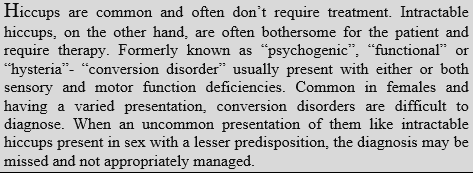Conversion disorder presenting as intractable hiccups in middle-aged male
Abstract
Hiccups are common and often don’t require treatment. Intractable hiccups, on the other hand, are often bothersome for the patient and require therapy. Formerly known as “psychogenic”, “functional” or “hysteria”- “conversion disorder” usually present with either or both sensory and motor function deficiencies. Common in females and having a varied presentation, conversion disorders are difficult to diagnose. When an uncommon presentation of them like intractable hiccups present in sex with a lesser predisposition, the diagnosis may be missed and not appropriately managed.
Downloads
References
Diagnostic and Statistical Manual of Mental Disorders Fifth Edition DSM - 5. Washington DC; American Psychiatry Association, 2013; 318-21.
Chadda RK. Somatoform Disorders. In, Ahuja N, Vyas JN (Eds). Textbook of Postgraduate Psychiatry. New Delhi: Jaypee Brothers Medical Publishers Ltd. 1999; 280-94.
Sadock BJ, Sadock VA. Kaplan & Sadock’s Synopsis of Psychiatry. 10th Edition, New Delhi: Wolters Kluwer (India) Pvt. Ltd. 2007; 634-42.
Chang FY, Lu CL. Hiccup: Mystery, nature, and treatment. J Neurogastroenterol Motil. 2012; 18: 123-130.
Howard RS. Persistent hiccups. BMJ. 1992; 305: 1237–1238.
Becker DE. Nausea, vomiting, and hiccups: a review of mechanisms and treatment. Anesth Prog. 2010; 57: 150-156.
Erarslan E. Successful Treatment of Intractable Hiccups due to Psychosomatic Disorder. J Gastroenterol Forecast. 2018; 1(2): 1008.
Guggenheim FG. Somatoform disorders. In: Kaplan HI, Sadock VA, editors. Comprehensive Textbook of Psychiatry, 7th edition. Baltimore, Lippincott Williams and Wilkins 2000; 1504–32.
Campo JV, Negrini BJ. Case study: negative reinforcement and behavioral management of conversion disorder. J Am Acad Child Adolesc Psychiatry 2000; 39: 787-90.



























